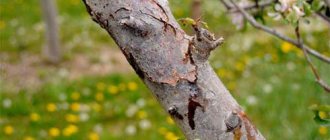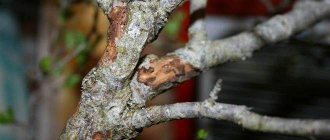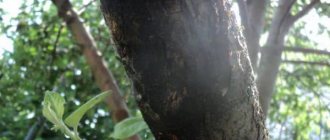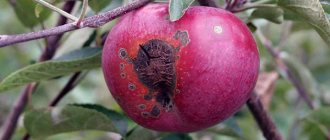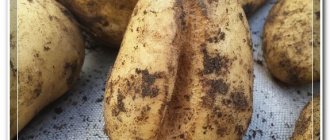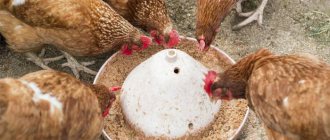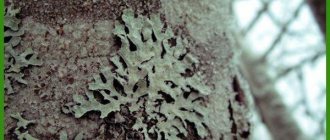Cracks in apple trees should alert the gardener! If you do not start fighting them in time, then not only the harvest may be reduced, but the entire tree may die.
The disease can spread to other fruit trees and in a short time affect almost the entire garden, causing serious damage .
From this article you will learn why the bark on apple trees bursts and how to prevent cracks from appearing on the trunk of your tree and what to do with them if they have already appeared.
If the bark cracks and...
Gets wet
The reasons that lead to wetting and cracking of the apple tree bark can be different.
The most common cause may be improper tree pruning , poor treatment and disinfection of wounds.
Wood rotting can begin due to water, microbes, viruses or fungi entering the cut site from the air.
Turns black
If the trunk of an apple tree cracks and turns black, this means that the tree has contracted the most terrible disease called black cancer .
In this case, the bark of the tree peels off and falls off, exposing the black wood.
The disease spreads to the branches and crown.
The disease destroys the tree within 3-4 years. If the disease is not detected at the very beginning of development, then it will no longer be possible to save the tree.
Peels off
Cracks and peeling of the bark can be caused by a number of reasons. For example, due to sharp changes in day and night temperatures, the bark of a tree loses its elasticity and longitudinal cracks appear.
And severe frosts, sunburn or fungal diseases can lead to more dangerous transverse cracking , which can lead to the death of the tree.
The bark bursts and the fruits dry out
If the bark of an apple tree bursts, then due to a lack of nutrients, the fruits on it may dry out, since if the bark is significantly damaged, beneficial substances from the soil do not reach the fruits.
Such wounds can appear on the tree as a result of poor-quality pruning , as well as freezing in severe winter conditions in low-winter-hardy varieties.
Yellow lichen and peeling bark
The older the apple tree, the greater its risk of developing lichen .
As a rule, it appears on the trunk and branches at high humidity and low temperature.
The lichen is white to yellow in color and spreads very quickly.
fungal diseases may appear on the tree , which lead to decomposition of the bark.
Classification of cracks
There are many variations of cracks on an apple tree, their shape and appearance indicate the severity of the damage.
There are ring, round, transverse and longitudinal types of damage.
Ring
Ring cracks are the most dangerous for an apple tree, especially in the form of a closed encircling ring. All tissues above the wound are left without nutrition and die soon. Sometimes an apple tree has the opportunity to be saved, but only by timely grafting with a “bridge” or a piece of bark.
Round holes and bark peelings
When holes a couple of millimeters in diameter, round in shape, are noted on the bark, and peeling is also visible, this signals the introduction of wood-boring pests. The beetles move inside the tree, disrupting nutrition and shoot development. When drying of the bark and its cracking are noticeable, this indicates a late stage before the death of the crop.
Transverse and longitudinal cracks
Cracks in the bark require urgent treatment, regardless of whether they are transverse or longitudinal. Longitudinal damage sometimes appears due to the difference in the growth rate of the inner and outer layers, because of the temperature difference. They are able to heal on their own, but there is a risk of infection.
It is necessary to carefully examine the cracks; sometimes they are a sign of serious illness.
Transverse and longitudinal holes of irregular shape on the south side are formed due to sunburn. This case is safer for the apple tree than the appearance of damage due to disease.
In August
In August, after a dry summer, the rainy season begins, which causes rapid wood growth .
This is the reason why the bark of an apple tree cracks.
The tree bark lacks elasticity, it does not withstand and cracks along the trunk. Such wounds are not dangerous for the tree; they should be washed with a 3-5% solution of iron sulfate , and the tree trunk should be whitened with the addition of 100-300 ml of copper sulfate per 10 liters of solution.
Restoration of the cortex after mechanical damage
Broken branches are cut to the base, and the damaged areas are carefully coated with garden varnish. Some gardeners use this product to treat small cracks, even though the tree repairs itself.
When a large branch breaks off and the trunk is split, Bugorkov's balm or oil paint based on drying oil is used for processing. An ointment made from several components is effective as an additional lubricant:
- "Immunocytophyte";
- wood ash;
- "Kornevin";
- BF glue;
- "Fundazol".
Get healing putty as follows:
- mix wood ash, Fundazol and Kornevin;
- crush the “Immunocytrophyte” tablet and add to the ingredients;
- add BF-6 glue to the mixture and mix thoroughly.
A properly prepared mixture should have a consistency similar to thick sour cream.
When treating wounds with this ointment, they necessarily cover a small area of healthy bark.
In case of significant damage, especially caused by pests, the bark is cleaned. After this, treatment is carried out with a disinfectant containing copper: a solution of copper sulfate (1%), etc. In order to stimulate healing, wood wounds are covered with a mixture prepared from mullein and clay in a ratio of 1: 1. As an option, pure clay is used, first softening Mature trees are whitewashed.
To treat wounds of any origin, it is unacceptable to use kerosene, tar and other products derived from petroleum.
Special designs made in the form of a cap allow you to protect apple trees from rodents. They are usually made from coniferous branches, reeds or corn. These improvised means are tightly wrapped around the trunk and lower branches. With the arrival of spring, the shelter is removed.
If the rodents still managed to damage the bark, the tree is treated using the same methods as in the case of other non-infectious wounds. A serious problem, when the bark is eaten away in rings, is eliminated by grafting with a “bridge”. Its principle is that unique bridges from grafted cuttings are laid across the damaged fragment of the trunk. In the future, it is through them that the sap will flow.
in spring
Cracking of the bark of apple trees most often occurs in early spring; it is associated with sharp fluctuations in air temperature .
On clear sunny days, the bark of trees becomes very hot. Sunburn occurs and tissue structure is damaged.
As a result of such damage, entire sections of the cortex can die..
Such phenomena can occur in apple trees that grow in too wet soil or are planted very deeply. And also if the tree variety is slightly winter-hardy.
The bark of an apple tree is cracking - what to do?
Apple tree care
Frost cracks in the bark.
The reasons for peeling bark on an apple tree are different. If there are few wounds, the tree can cope on its own and continue to bear fruit.
But if such damage is significant, it can lead to the death of the tree . In such cases, it is necessary to carry out a number of measures aimed at saving the apple tree.
Damaged areas should be cleaned with a disinfected instrument.
This must be done carefully, without touching the healthy bark.
After cleaning, they must be washed with a solution of potassium permanganate, brilliant green or hydrogen peroxide . After drying, cover it with garden varnish, wrap it well with black polyethylene, you can tie it with burlap or any unnecessary fabric in several layers to prevent infection.
As a result of this treatment, the wounds will heal, the recovery process will begin and the incision will heal. The peeled bark fragments should be removed from the area.
ADVICE! Having completed urgent procedures to save apple trees, it is advisable to treat the entire garden with a 3% Bordeaux mixture, which will protect it from many diseases.
Do apple trees need to be replanted?
In practice, bark cracking is most often observed in old apple trees. At the same time, you should not replant a damaged tree with a disease of the trunk bark , since replanting an adult tree is always a very labor-intensive process.
And the survival rate of diseased trees in a new place is very low, and your work will become useless.
sick trees at all; there is a high probability that they will die.
It is best to replace them with new seedlings, but if your old apple tree is very dear to you, then depending on the degree of the disease, you can try to save it.
ADVICE! For example, if the bark is cracked around a branch, then it should be completely removed. This way you can eliminate the infectious focus, encourage the tree to grow further and thus create a rejuvenation effect.
How to save an old apple tree?
Trees, like people, have a tendency to age. Over the years, they also begin to get sick. One of these diseases, characteristic of old plants, is cracking and peeling of the bark.
Depending on the degree of the disease, a number of simple operations can be performed to save your beloved tree.
- If the disease has affected small areas, then using a metal brush, previously disinfected, you must carefully remove all loose bark.
- With it you will remove all kinds of pests.
- After which it is necessary to whitewash all cleaned areas with thick lime , as well as other trunks and branches to prevent fungal diseases and sun exposure. You can add mullein , this will strengthen the plant.
ADVICE! If the damage has affected large areas, then the diseased branches can be cut down, and the cut areas must be treated with garden varnish in order to protect against insects and other pests, as well as fungal and infectious diseases.
Main causes of cortical deformation
When the bark of an apple tree is cracked, this may indicate fungal damage, cancer, cytosporosis, bacterial burn, pest attack, heating, frost damage and sunburn. The most dangerous are cracks caused by oncology. The disease is practically incurable; there is a chance to save the tree only if the disease is detected in the early stages.
Fungal infection
An apple tree is sometimes attacked by pathogenic fungi, which can cause the trunk to crack. Their appearance is provoked by dampness and warming. Fungi are destroyed with fungicides and Bordeaux mixture.
Cancer
The tree is inhabited by two types of cancer: black “Antonov fire” and nektria - open cancer, “European”, or “common”. In the first case, the pathology proceeds harmfully and quickly; the infected apple tree dies within 1-4 years, in the absence of treatment. Diseases are introduced into the plant through breaks, saw cuts, and frost holes.
Black cancer is provoked by colonies of fungi - brown pits with a blackish coating, ringing the trunk, the forks of large branches.
Afterwards, many black bumps like “goose bumps” form on the surface. The bark peels off, cracks, revealing dark wounds down to the core of the tree.
Ordinary cancer develops more slowly. Deep cracks are surrounded by reddish tubercles and growths. The trunks, forks of skeletal shoots, and lateral branches are affected. The bark and wood die off, the resistance of apple trees to natural factors, the quantity and quality of the harvest decreases. A severely affected plant withers due to an imbalance in water and carbohydrate balance. Infection occurs through broken pieces, wounds, and cuts. The first symptoms are usually visible during a thaw.
See also
Methods of combating bark beetle on an apple tree and the best means to get rid of the parasite
Read
Cytosporosis
A fungal disease of an infectious nature stimulates the drying out of shoots. They do not receive nutrition due to the fact that the movement of sap occurs only in the bark. Under the influence of toxins released by the fungus, the bark dries out, becomes spongy, and stops conducting juices. After a while, it darkens and dies off along with the shoots.
The causative agents of cytosporosis include the fungi Cytospora carphosperma Fr. and Cytospora copitata Sacc et Schnalz. The disease affects young, mature and old trees.
Damage to the apple tree - hollows, sores, open cracks, frostbite, burns - appears as a source of infection. Fungi are carried by wind and beetles. Pathogenic microorganisms overwinter on infected shoots as spores. For pathology to develop successfully, high humidity is required. Apple trees are not resistant to cytosporosis in winter and rainy autumn.
Bacterial burn
Bacterial agents spread throughout the tree with cell sap, penetrating into it through wounds that have received pollen from diseased apple trees. The shoots are green and the flowers dry up quickly, as if they were burned. The bark cracks, a sticky whitish mass is released, which subsequently darkens.
The reddish dead cambium is visible. Parts of the bush and even trees die within 1-2 years.
In the initial stages of pathology, sometimes the plant can be saved by removing the affected branches with a disinfected tool. Regular spraying 5 times during the growing season with the biological product Fitolavin or the antibiotic Ampicillin also helps.
Frostbites and sunburn
Such damage consists of necrosis and cracks in the bark, sometimes with partial extension to the wood. They arise due to frosts, sudden changes in weather in winter, in the off-season. In March, the sun's rays heat the dark trunks when reflected from the white snow. Night frosts quickly cool the plant tissues, causing their deformation, partial death, and the bark comes off. The best preventive measures include planting winter-hardy varieties and whitewashing. If wounds have already occurred, they are disinfected and covered.
Warming up
Undergrowth of the bark occurs if the tissues have not matured well by the autumn time, and in the winter they collapse due to dampness and weather changes. Sometimes the reason is an unstable rootstock or very deep snow cover. Saplings and young trees are often subjected to heating. When the bark has dried out and peels off all around, after warming, the affected apple tree can begin to bloom due to the reserves of nutrients in the trunk. No juices come from the roots, the plant gradually dries out. When the pathology is detected not too late, the tree can be saved by grafting.
Pests
When the bark of an apple tree bursts, this may signal the activity of stem pests such as woodworms, bark beetles, sapwood, and rodents. They can destroy the tree; urgent spraying with insecticides is required.
Sapwood beetles
Fruit sapwood is a red-brown bark beetle, 3.5-4 mm in size. The insect attacks weakened apple trees, but can also settle on a healthy tree. Symptoms include small round holes. When pests severely infect apple trees, cracks appear.
Woodworm butterflies
Woodworm larvae live inside the apple tree, gnaw passages and grooves in the internal tissues. The nutrition of the tree is disrupted. Shoots damaged by caterpillars lose their natural elasticity and strength, and are easily broken by wind gusts. If the damage is significant, the apple tree may die. Symptoms of infection include the presence of a reddish or brown wormhole on the surface of the bark, which the tree throws out of the hole. Caterpillars are 5-7 mm in diameter and begin to attack trees when the air temperature rises from +10.
Damage by bark beetles
The bark beetle is a harmful pest for orchards. During mass reproduction, insects can destroy even an adult apple tree in 1.5-2 months. The tree becomes dehydrated and can dry out over the summer.
See also
What to do if an apple tree drops fruits before they ripen and the main reasons
Read
How to deal with bark beetle?
One of the common dangers to cultivated plants is insect pests .
Apple orchard pests.
The most problematic of them are insects that live under the bark of trees. These include bark beetles , which not only weaken the tree, but can even destroy it.
At the same time, they attack to a greater extent weakened plants that have cracks, burns, and wounds . It is very difficult to fight them, since they live inside the wood. Methods of controlling bark beetles depend on the degree of damage to the tree.
If the bark of an apple tree peels off in many places and insect passages are found there, and there are obvious signs of wilting of the tree, then most likely it cannot be saved.
It needs to be cut down, the stump uprooted and removed from the site.
ATTENTION . In this case, you need to carefully consider weak trees, since bark beetles can use them for new nests, and they may also need to be removed.
If one or two holes with small sawdust are found on the tree and the tree looks healthy, then measures must be taken to get rid of insects.
A means to kill garden pests is applied several times into the detected holes using a syringe.
Such drugs are:
- "Anti-bug"
- "Calypso",
- "Antishashelin»
- and others.
After the medicine is absorbed, the passages must be treated with garden varnish.
Damage by bark beetles
Bark beetles (sapwood, wood beetles) are a whole family of beetles. Several species can cause damage in apple orchards.
Bark beetle larvae.
Adult bark beetles.
Some are common only in the south ( Crimea, Caucasus ), others are found everywhere . Varieties of sapwood, such as fruit and wrinkled, attack the trunks and large branches of weakened plants (for example, those suffering from drought). Western gypsy grass attacks healthy trees.
Signs of defeat
Upon closer inspection, small round holes are visible on the surface, with wood dust around them.
You should inspect the bark of all trees in the garden more often in order to detect signs of beetles, because bark beetles live not only on apple trees, but also on other fruit crops.
Deep sections make it possible to detect passages inside the trunk inhabited by beetles, larvae or oviposition. Nearby branches stop growing and gradually wither. Over time, the bark can come off in layers and the tree dies.
Sometimes death occurs quickly - literally within one season . Woodpeckers often notice pests much earlier than humans, and a visit to a tree by these birds is an alarming signal .
Control measures
Regular inspection of the garden allows you to identify affected apple trees.
Any potent insect repellent is suitable for killing beetles and their larvae.
It is necessary to inject a strong solution of an insecticidal preparation into the holes ( Lightning Extra, Shar Pei, Iskra Double Effect, Inta-CM, Alatar ) using a syringe with a long needle. Then the hole is covered with varnish or filled with a specially prepared mixture. Its composition: paraffin, rosin, vegetable oil in a proportion of 6:3:2 . The mixture is boiled for 10 minutes, cooled; You can add a little copper-containing drug ( HOM, Oxychom ).
Spraying the garden immediately after flowering and again after half a month helps prevent infection. For this purpose, pesticides are used - chemical ( Alatar, Inta-CM ) or biological ( Lepidocid, Bitoxibacillin ).
Whitewashing apple trees as a control measure
When the bark of an apple tree cracks - what to do if this happens to old apple trees.
The package of measures to combat these diseases includes whitewashing.
This simple procedure consists of the following rules:
- You need to spread a film or fabric under the crown of the tree.
- Use a special tool to carefully clean the old bark.
- Cover the cleaned areas with garden varnish.
- Proceed to whitewash the cleaned areas and the tree trunk with lime.
- All waste must be collected and removed from the site or incinerated .
What if there are problems with the bark?
Whitewashing an apple tree.
At a young apple tree
Young apple trees may suffer from various weakening factors. The resulting cracks cause infections .
To combat them you need:
- Cut cracks to healthy parts (up to 2 cm deep);
- Spill them with iron (3-5%) or copper sulfate (2%);
- Lubricate with special lubricant.
- Whiten the trunk;
- Remove all debris from the site.
- Before winter, it is advisable to dig up the soil around the trunk.
ADVICE. Before spring flowering, you can feed the tree with fertilizer containing boron and magnesium.
At the seedling
wet soil, those planted deeply or overfed with fertilizers, as well as weakly winter-hardy varieties are prone to the formation of cracks in the bark
In addition to these factors, we must also add that during the period of active growth, the trunk of young trees thickens, the bark on young trees stretches and bursts.
In this case, you can use a sharp knife to make longitudinal cuts in the . It will diverge by 1-2 mm, but soon the incisions will heal.
What to do
If this problem is not solved in a timely manner, pathogenic bacteria, as well as larvae of harmful insects, accumulate in the cracks. This may negatively affect the growth of the tree.
To treat sunburn, you need to use an iron scraper to remove dead tissue.
Important! It is necessary to work with the tool carefully so as not to damage healthy tissue. Then soak the cloth in the Bordeaux mixture and moisten the tree bark
After 2 - 3 hours, the wound on the bark must be treated with garden varnish. To prepare it, beeswax, sulfur and lighter gasoline are mixed. Dissolve the mixture in a water bath and stir
Then soak the cloth in the Bordeaux mixture and moisten the tree bark. After 2 - 3 hours, the wound on the bark must be treated with garden varnish. To prepare it, beeswax, sulfur and lighter gasoline are mixed. Dissolve the mixture in a water bath and stir.
If the cracks are formed as a result of the influence of rodents, such plants must be pruned short in early spring. Treat the damaged areas with a weak solution of potassium permanganate, and then lubricate with garden varnish. Such trees require special care and attention. This is necessary for the tree to gain strength and become stronger after damage.
If the cause of the formation of cracks is damage to the hyaloderm by insects, experienced gardeners recommend establishing the degree of damage to the bark. To do this, carefully pierce the wood with a knife. If healthy and hard areas are felt underneath, the plant can still be saved. To do this, an iron scraper is used to remove old and damaged bark, under which not only insects, but also their larvae accumulate. After this, the tree trunk is treated with preparations such as Kanfidor, Calypso or Antizhuk. If deep cracks are visible on the trunk, the drug is injected into them with a syringe. After a few days, the tree trunk needs to be whitened with lime.
The trees need to be whitened with lime
If large cracks have formed on the plant (more than 10 cm wide), it is more difficult to help it. After removing the old bark, you need to put a layer of a mixture of clay and cow dung on the wound. The lubricated area is wrapped in plastic film, which is fixed to the stem with a rope. This will help prevent the mixture from drying out.
Advice!
You can also use Nitrol. This is machine oil that helps get rid of cracks in the bark in a few months.
Often, during severe frosts, frost cracks can form in the bark of a tree. They take much longer to heal. To do this, experienced gardeners recommend adhering to the following recommendations:
- It is better to start treatment in the summer.
- Remove any damaged or dead bark using an iron scraper.
- Treat cracks with 5% copper sulfate.
- After the solution has dried, lubricate the damaged area with garden varnish.
- If the wound is large, the tree trunk is tightened with strong wire. This will help speed up the healing process of the crack.
Sometimes the cause of cracks is infection with black cancer. The disease is caused by a pathogenic fungus whose spores spread quite quickly. Symptoms of the disease are the appearance of purple spots on the bark, which gradually turn into cracks. To treat such a plant, it is necessary to remove the old hyaloderm and disinfect the affected area. To do this, you can use Bordeaux mixture, copper sulfate or potassium permanganate solution. 2 - 3 hours after this, the treated area is smeared with garden varnish. If the degree of damage to the bark does not allow removing the diseased area, experienced gardeners recommend destroying the plant. This will prevent infection of other fruit trees in the garden.
Tree care is important
The bark of a young apple tree is cracking at the base
In a young apple tree, especially in August , the bark at the base may crack. So why does the trunk of an apple tree crack?
This happens because after a dry summer, the season of heavy rains begins, the wood of a young tree begins to grow rapidly , and the bark has already completed its seasonal growth and lacks elasticity.
IMPORTANT! This phenomenon poses a danger to the wintering of the tree. The bark of an apple tree is cracking; what to do is a serious question for a gardener.
After all, if you dig the base of the trunk with earth, it will support , which will lead to spring detachment.
If this is not done, the exposed parts of the wood may freeze.
In this case, in the fall it is necessary to cover the places of delamination with garden pitch, and in the winter it is necessary to cover them with snow.
How to cover a cut on an apple tree?
After the cleaned and disinfected cut on the apple tree dries, it must be covered with a special product. This is done to seal damage to close the entrance for pests, bacteria and fungi.
In addition, in the place of an unprotected cut, the branch may begin to dry out. This happens because:
- Sap flow is disrupted, nutrients do not reach the part of the branch that is located above the damage;
- Moisture evaporates through the wound.
An unprotected wound is prone to cracking, and sometimes the cracks are deep. A hollow may form in the place where the saw cut damaged the bark of the apple tree.
The following is used as putty:
- Garden var;
- A thick mash of clay and mullein;
- Oil paints on natural drying oil;
- Cement mortar – for particularly large damages;
- Water-based paints;
- Artificial bark (balm - varnish).
Garden var.
Garden varnish can be purchased at the store, or you can prepare it yourself. To prepare it, wax, rosin and fat are used.
The wax does not allow water to reach the wood and does not allow the putty to drain from the wound. The stickiness of rosin allows the varnish to firmly bond to the wood. Fat prevents the putty from cracking in any weather.
Any unsalted fat is suitable. You can replace it with vegetable oil or natural drying oil. Turpentine is suitable instead of wax.
Take 1 part each of rosin and fat, and 2 parts of wax. Rosin, wax and fat are melted separately and then mixed. This solution is slowly poured into cold water. Take out after hardening; Also mix 20 parts of paraffin, 4 parts of rosin and 1 part of drying oil; Rosin and wax 2 parts each, vegetable oil - 1; Rosin 1.5 parts, oil - 2. Heat, mix and pour in 1 part of turpentine
It is important to do this away from the fire.
You can add ash to the garden pitch.
IMPORTANT! Before application, the garden pitch is slightly heated to soften it. Apply a very thin layer so that it seems that a thin film has been applied to the cut. If you cover the cuts on apple trees with a thick layer of garden varnish, the wood underneath will begin to rot after a while
If you cover the cuts on apple trees with a thick layer of garden varnish, the wood underneath will begin to rot after a while.
Clay chatter.
Clay mash: to prepare clay putty, take 2 parts clay, 1 part mullein, a little chopped straw or hay. Stir and dilute with water to the consistency of sour cream.
Cement mortar: 1 part cement, 3 parts fine sand mixed with water and a little drying oil added. Suitable for filling deep wounds and cracks.
Oil-based and water-based paints are washed off by rain after a while and will have to be renewed.
IMPORTANT! Apply any putty only to damaged wood. The edges of the bark must remain clean so that they can form a bark ridge that will heal the wound.
